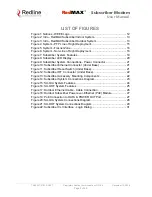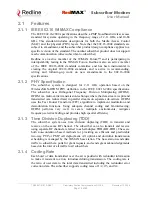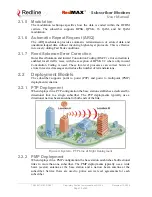
Red
MAX
™
Subscriber Modem
User Manual
70-00057-01-01-DRAFT
Proprietary Redline Communications © 2006
December
13,
2006
Page 18 of 60
Setup messages are sent by the base station following any subscriber power-cycle,
loss and recovery of the wireless link to a subscriber, or any service flow
add/delete operation at the base station.
2.3.3 Uplink Service Flow Scheduling
The base station enforces QoS settings for each service flow by controlling all
uplink and downlink traffic scheduling. This provides non-contention based
traffic model with predictable transmission characteristics. By analyzing the
aggregate requests of all subscribers, the base station ensures that uplink and
downlink traffic conforms with the current service level agreements (SLAs).
Centralized scheduling increases traffic predictability, eliminates contention, and
provides maximum opportunity for reducing overhead.
Real-Time Polling Service (rt-PS)
The base station schedules a continuous regular series of transmit opportunities
for the subscriber to send variable size data packets. The grant size is based on the
current data transfer requirement. Typical applications include streaming MPEG
video or VOIP with silence suppression. This is efficient for applications that
have a real-time component and continuously changing bandwidth requirements.
Non-Real-Time Polling Service (nrt-PS)
The base station schedules regular transmit opportunities for the subscriber to
send variable size data packets. Typical applications may include high bandwidth
FTP. The polling period may typically be one second or less, even during periods
of network congestion.
Best Effort (BE)
The base station schedules transmit opportunities for the subscriber to send traffic
based on unused bandwidth after all higher level traffic scheduling requirements
are serviced. Typical applications may include Internet access and email. Best
effort service flows can be assigned a priority of 0 to 7.
Unsolicited Grant Service (UGS)
The base station schedules a continuous series of transmit opportunities for the
subscriber to send fixed size data packets. This schedule supports real-time
applications including VoIP or TDM transport. The UGS pre-scheduled grants
guarantee reserved bandwidth and reduce latency introduced by repetitive grant
requests. The service flow will not transmit packets larger than nominal grant
interval.
2.3.4 Downlink Service Flow Scheduling
The base station schedules downlink traffic on active service flows based on the
minimum reserved data rate (CIR), traffic priority, and maximum latency.
















































